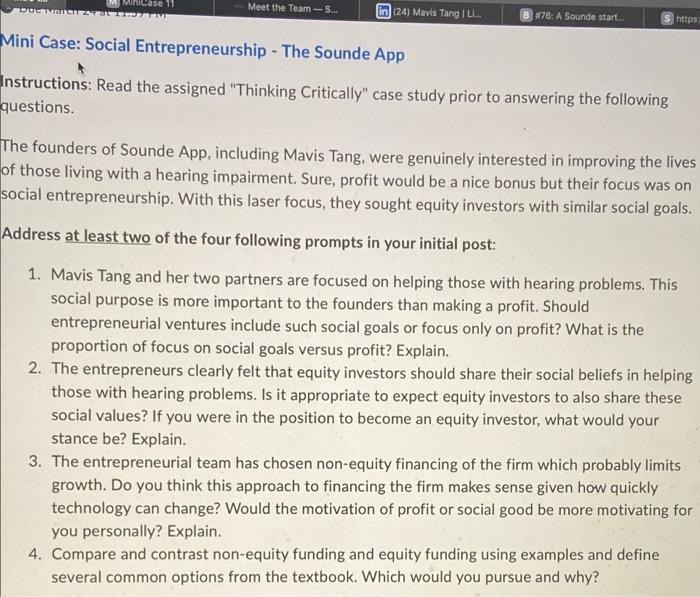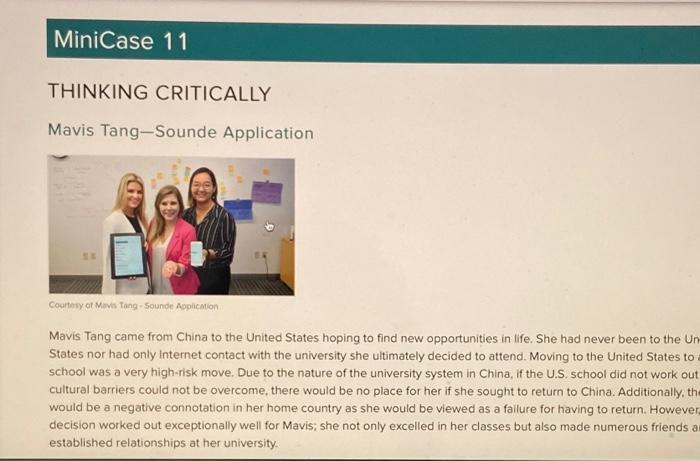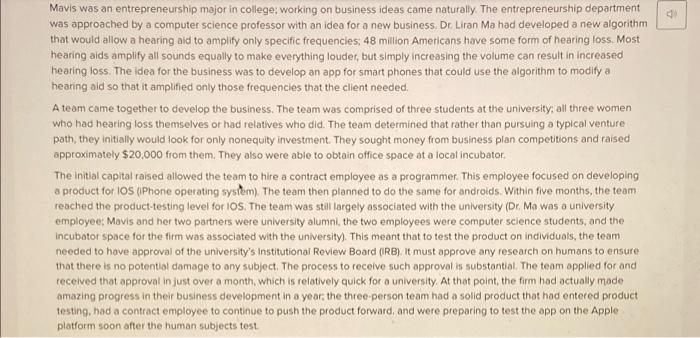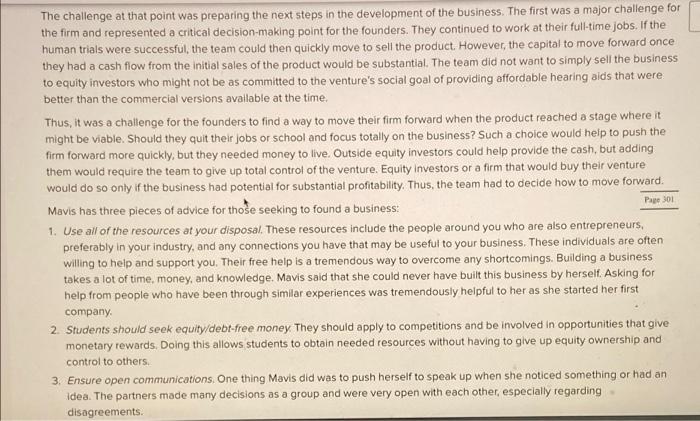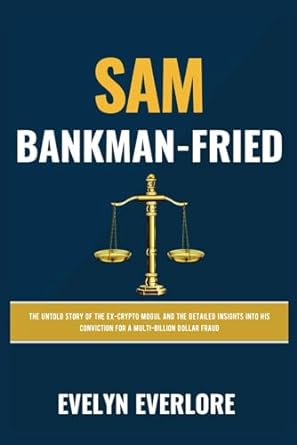MiniCase 11 DOC MOTOR Meet the Team-S.. in (24) Mavis Tang L. 8-76: A Sounde start S https Mini Case: Social Entrepreneurship - The Sounde App Instructions: Read the assigned "Thinking Critically" case study prior to answering the following questions. The founders of Sounde App, including Mavis Tang, were genuinely interested in improving the lives of those living with a hearing impairment. Sure, profit would be a nice bonus but their focus was on social entrepreneurship. With this laser focus, they sought equity investors with similar social goals. Address at least two of the four following prompts in your initial post: 1. Mavis Tang and her two partners are focused on helping those with hearing problems. This social purpose is more important to the founders than making a profit. Should entrepreneurial ventures include such social goals or focus only on profit? What is the proportion of focus on social goals versus profit? Explain. 2. The entrepreneurs clearly felt that equity investors should share their social beliefs in helping those with hearing problems. Is it appropriate to expect equity investors to also share these social values? If you were in the position to become an equity investor, what would your stance be? Explain. 3. The entrepreneurial team has chosen non-equity financing of the firm which probably limits growth. Do you think this approach to financing the firm makes sense given how quickly technology can change? Would the motivation of profit or social good be more motivating for you personally? Explain. 4. Compare and contrast non-equity funding and equity funding using examples and define several common options from the textbook. Which would you pursue and why? MiniCase 11 THINKING CRITICALLY Mavis Tang-Sounde Application Courtesy or Movies Tang - Sounde Application Mavis Tang came from China to the United States hoping to find new opportunities in life. She had never been to the Un States nor had only Internet contact with the university she ultimately decided to attend. Moving to the United States to school was a very high-risk move. Due to the nature of the university system in China, If the U.S. school did not work out cultural barriers could not be overcome, there would be no place for her if she sought to return to China. Additionally, the would be a negative connotation in her home country as she would be viewed as a failure for having to return. However decision worked out exceptionally well for Mavis, she not only excelled in her classes but also made numerous friends a established relationships at her university Mavis was an entrepreneurship major in college: working on business ideas came naturally. The entrepreneurship department was approached by a computer science professor with an idea for a new business, Dr Liran Ma had developed a new algorithm that would allow a hearing aid to amplify only specific frequencies; 48 million Americans have some form of hearing loss. Most hearing aids amplify all sounds equally to make everything louder, but simply increasing the volume can result in increased hearing loss. The idea for the business was to develop an app for smart phones that could use the algorithm to modify a hearing aid so that it amplified only those frequencies that the client needed A team came together to develop the business. The team was comprised of three students at the university, all three women who had hearing loss themselves or had relatives who did. The team determined that rather than pursuing a typical venture path, they initially would look for only nonequity investment. They sought money from business plan competitions and raised approximately $20,000 from them. They also were able to obtain office space at a local incubator, The Initial capital raised allowed the team to hire a contract employee as a programmer. This employee focused on developing a product for los qPhone operating system). The team then planned to do the same for androids. Within five months, the team reached the product testing level for IOS. The team was still largely associated with the university (Dr Mo was a university employee: Mavis and her two partners were university alumni, the two employees were computer science students, and the incubator space for the firm was associated with the university). This meant that to test the product on individuals, the team needed to have approval of the university's Institutional Review Board (RB). It must approve any research on humans to ensure that there is no potential damage to any subject. The process to receive such approval is substantial. The team applied for and received that approval in just over a month, which is relatively quick for a university. At that point, the firm hod actually made amazing progress in their business development in a year, the three-person team had a solid product that had entered product testing, had a contract employee to continue to push the product forward, and were preparing to test the app on the Apple platform soon after the human subjects test. Page 301 The challenge at that point was preparing the next steps in the development of the business. The first was a major challenge for the firm and represented a critical decision-making point for the founders. They continued to work at their full-time jobs. If the human trials were successful, the team could then quickly move to sell the product. However, the capital to move forward once they had a cash flow from the initial sales of the product would be substantial. The team did not want to simply sell the business to equity investors who might not be as committed to the venture's social goal of providing affordable hearing aids that were better than the commercial versions available at the time. Thus, it was a challenge for the founders to find a way to move their firm forward when the product reached a stage where it might be viable. Should they quit their jobs or school and focus totally on the business? Such a choice would help to push the firm forward more quickly, but they needed money to live. Outside equity investors could help provide the cash, but adding them would require the team to give up total control of the venture. Equity investors or a firm that would buy their venture would do so only if the business had potential for substantial profitability. Thus, the team had to decide how to move forward. Mavis has three pieces of advice for thoe seeking to found a business: 1. Use all of the resources at your disposal. These resources include the people around you who are also entrepreneurs, preferably in your industry, and any connections you have that may be useful to your business. These individuals are often willing to help and support you. Their free help is a tremendous way to overcome any shortcomings. Building a business takes a lot of time, money, and knowledge. Mavis said that she could never have built this business by herself. Asking for help from people who have been through similar experiences was tremendously helpful to her as she started her first company 2. Students should seek equity/debt-free money. They should apply to competitions and be involved in opportunities that give monetary rewards. Doing this allows students to obtain needed resources without having to give up equity ownership and control to others 3. Ensure open communications. One thing Mavis did was to push herself to speak up when she noticed something or had an Idea. The partners made many decisions as a group and were very open with each other, especially regarding disagreements. MiniCase 11 DOC MOTOR Meet the Team-S.. in (24) Mavis Tang L. 8-76: A Sounde start S https Mini Case: Social Entrepreneurship - The Sounde App Instructions: Read the assigned "Thinking Critically" case study prior to answering the following questions. The founders of Sounde App, including Mavis Tang, were genuinely interested in improving the lives of those living with a hearing impairment. Sure, profit would be a nice bonus but their focus was on social entrepreneurship. With this laser focus, they sought equity investors with similar social goals. Address at least two of the four following prompts in your initial post: 1. Mavis Tang and her two partners are focused on helping those with hearing problems. This social purpose is more important to the founders than making a profit. Should entrepreneurial ventures include such social goals or focus only on profit? What is the proportion of focus on social goals versus profit? Explain. 2. The entrepreneurs clearly felt that equity investors should share their social beliefs in helping those with hearing problems. Is it appropriate to expect equity investors to also share these social values? If you were in the position to become an equity investor, what would your stance be? Explain. 3. The entrepreneurial team has chosen non-equity financing of the firm which probably limits growth. Do you think this approach to financing the firm makes sense given how quickly technology can change? Would the motivation of profit or social good be more motivating for you personally? Explain. 4. Compare and contrast non-equity funding and equity funding using examples and define several common options from the textbook. Which would you pursue and why? MiniCase 11 THINKING CRITICALLY Mavis Tang-Sounde Application Courtesy or Movies Tang - Sounde Application Mavis Tang came from China to the United States hoping to find new opportunities in life. She had never been to the Un States nor had only Internet contact with the university she ultimately decided to attend. Moving to the United States to school was a very high-risk move. Due to the nature of the university system in China, If the U.S. school did not work out cultural barriers could not be overcome, there would be no place for her if she sought to return to China. Additionally, the would be a negative connotation in her home country as she would be viewed as a failure for having to return. However decision worked out exceptionally well for Mavis, she not only excelled in her classes but also made numerous friends a established relationships at her university Mavis was an entrepreneurship major in college: working on business ideas came naturally. The entrepreneurship department was approached by a computer science professor with an idea for a new business, Dr Liran Ma had developed a new algorithm that would allow a hearing aid to amplify only specific frequencies; 48 million Americans have some form of hearing loss. Most hearing aids amplify all sounds equally to make everything louder, but simply increasing the volume can result in increased hearing loss. The idea for the business was to develop an app for smart phones that could use the algorithm to modify a hearing aid so that it amplified only those frequencies that the client needed A team came together to develop the business. The team was comprised of three students at the university, all three women who had hearing loss themselves or had relatives who did. The team determined that rather than pursuing a typical venture path, they initially would look for only nonequity investment. They sought money from business plan competitions and raised approximately $20,000 from them. They also were able to obtain office space at a local incubator, The Initial capital raised allowed the team to hire a contract employee as a programmer. This employee focused on developing a product for los qPhone operating system). The team then planned to do the same for androids. Within five months, the team reached the product testing level for IOS. The team was still largely associated with the university (Dr Mo was a university employee: Mavis and her two partners were university alumni, the two employees were computer science students, and the incubator space for the firm was associated with the university). This meant that to test the product on individuals, the team needed to have approval of the university's Institutional Review Board (RB). It must approve any research on humans to ensure that there is no potential damage to any subject. The process to receive such approval is substantial. The team applied for and received that approval in just over a month, which is relatively quick for a university. At that point, the firm hod actually made amazing progress in their business development in a year, the three-person team had a solid product that had entered product testing, had a contract employee to continue to push the product forward, and were preparing to test the app on the Apple platform soon after the human subjects test. Page 301 The challenge at that point was preparing the next steps in the development of the business. The first was a major challenge for the firm and represented a critical decision-making point for the founders. They continued to work at their full-time jobs. If the human trials were successful, the team could then quickly move to sell the product. However, the capital to move forward once they had a cash flow from the initial sales of the product would be substantial. The team did not want to simply sell the business to equity investors who might not be as committed to the venture's social goal of providing affordable hearing aids that were better than the commercial versions available at the time. Thus, it was a challenge for the founders to find a way to move their firm forward when the product reached a stage where it might be viable. Should they quit their jobs or school and focus totally on the business? Such a choice would help to push the firm forward more quickly, but they needed money to live. Outside equity investors could help provide the cash, but adding them would require the team to give up total control of the venture. Equity investors or a firm that would buy their venture would do so only if the business had potential for substantial profitability. Thus, the team had to decide how to move forward. Mavis has three pieces of advice for thoe seeking to found a business: 1. Use all of the resources at your disposal. These resources include the people around you who are also entrepreneurs, preferably in your industry, and any connections you have that may be useful to your business. These individuals are often willing to help and support you. Their free help is a tremendous way to overcome any shortcomings. Building a business takes a lot of time, money, and knowledge. Mavis said that she could never have built this business by herself. Asking for help from people who have been through similar experiences was tremendously helpful to her as she started her first company 2. Students should seek equity/debt-free money. They should apply to competitions and be involved in opportunities that give monetary rewards. Doing this allows students to obtain needed resources without having to give up equity ownership and control to others 3. Ensure open communications. One thing Mavis did was to push herself to speak up when she noticed something or had an Idea. The partners made many decisions as a group and were very open with each other, especially regarding disagreements
